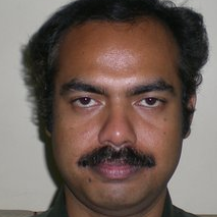International Journal of Image, Graphics and Signal Processing (IJIGSP)
IJIGSP Vol. 7, No. 3, 8 Feb. 2015
Cover page and Table of Contents: PDF (size: 651KB)
High Payload Watermarking using Residue Number System
Full Text (PDF, 651KB), PP.1-8
Views: 0 Downloads: 0
Author(s)
Index Terms
Watermarking, Payload, Residue Number System, Chinese Remainder Theorem, PSNR
Abstract
Information hiding or data hiding, also known as watermarking, has become a part and parcel of covert communication and copyright protection. Maximizing watermark payload is a major challenge for watermark researchers. To overcome this issue, we have proposed a new color image watermarking technique, using residue number system (RNS). RNS refers to a large integer using a set of smaller integers which relies on the Chinese remainder theorem of modular arithmetic for its operation. The proposed method takes pixel values from three watermark images and embeds them into the main cover image. Experimental results presented in this paper shows that the watermark can be successfully embedded and extracted from an image, without distorting the original image using the proposed technique. The high peak signal to noise ratio (PSNR) and payload values claims the robustness of the proposed method.
Cite This Paper
Shubhendu Banerjee, Sayan Chakraborty, Nilanjan Dey, Arijit Kumar Pal, Ruben Ray,"High Payload Watermarking using Residue Number System", IJIGSP, vol.7, no.3, pp.1-8, 2015. DOI: 10.5815/ijigsp.2015.03.01
Reference
[1]N.F. Johnson," An Introduction to Watermark Recovery from Images", Proceedings of the SANS Intrusion Detection and Response Conference (IDR'99) held in San Diego, CA, February 9-13, 1999.
[2]L. Chun-Shien, and M. L. Hong-Yuan, "Multipurpose Watermarking for Image Authentication and Protection", IEEE transactions on image processing, vol. 10, no. 10, October 2001.
[3]W. Wang, M.N.S. Swamy, and M.O. Ahmad, "RNS application for digital image processing", Proceedings. 4th IEEE International Workshop on System-on-Chip for Real-Time Applications, 2004.
[4]E. Castillo, A. Garcia, L. Parrilla, A. Lloris, and U. Meyer-Baese, "RNS-based Watermarking for IP Cores", Research in Microelectronics and Electronics 2006, Page(s): 357 - 360 ISBN: 1-4244-0157-7.
[5]S. Weng, Y. Zhao, P. Jeng-Shyang and R. Ni, "Reversible Watermarking Based on Invariability and Adjustment on Pixel Pairs", IEEE signal processing letters, vol. 15, 2008.
[6]G. Rosline, N. Kumari, B. VijayaKumar, L. Sumalatha, and V.V. Krishna, "Secure and Robust Digital Watermarking on Grey Level Images", International Journal of Advanced Science and Technology, Vol. 11,October,2009
[7]W. Hao-Tian and Y.M. Cheung, "Reversible Watermarking by Modulation and Security Enhancement", IEEE transactions on instrumentation and measurement, vol. 59, no. 1, January 2010.
[8]R. Naskar and R.S. Chakraborty, "Reversible Image Watermarking through Coordinate Logic Operation based Prediction", International Conference on Information Systems Security (ICISS) 2011, Kolkata, India. Published in Lecture Notes on Computer Science, vol. 7093, pp. 190-203, 2011.
[9]N. Dey, M. Pal, A. Das, "A Session Based Blind Watermarking Technique within the NROI of Retinal Fundus Images for Authentication Using DWT, Spread Spectrum and Harris Corner Detection" International Journal of Modern Engineering Research (IJMER),Vol.2, Issue.3,May-June 2012 pp-749-757,ISSN: 2249-6645.
[10]N. Dey, S. Mukhopadhyay, S.S. Chaudhuri, A. Das, "Analysis of P-QRS-T Components Modified by Blind Watermarking Technique Within the Electrocardiogram Signal for Authentication in Wireless Telecardiology Using DWT" International Journal of Image, Graphics and Signal Processing (IJIGSP)Vol.4, No.7, July 2012,ISSN: 2074-9074.
[11]N. Dey, P. Das, S. S. Chaudhuri, A. Das,"Feature analysis for the blind-watermarked electroencephalogram signal in wireless telemonitoring using Alattar's method", Proceedings.
[12]R. Naskar. and R. S. Chakraborty, "Reversible Watermarking Utilizing Weighted–median based Prediction", IET Image Processing, vol. 6, no. 5, Jul. 2012, pp. 507-520.
[13]R. Naskar and R.S. Chakraborty, "A Generalized Tamper Localization Approach for Reversible Watermarking Algorithms", ACM Transactions on Multimedia Computing Communications and Applications, vol. 9, no. 3, Jun. 2013, pp. 19:1-19:22.
[14]R. Naskar and R.S. Chakraborty, "Histogram–Bin–Shifting based Reversible Watermarking for Color Images", IET Image Processing, vol. 7, no. 2, Mar. 2013, pp. 99-110.
[15]P. Nagaraju, R. Naskar and R.S. Chakraborty, "Improved Histogram Bin Shifting based Reversible Watermarking", International Conference on Intelligent System and Signal Processing (ISSP) 2013, Anand, Gujarat, India.
[16]N. Dey, S. Samanta, S. Chakraborty, A. Das, S.S. Chaudhuri and J.S. Suri, "Firefly Algorithm in optimization of Scaling Factors for Manifold Medical Information Embedding", Journal of Medical Imaging and Health Informatics, vol. 4, no. 3, June 2014, pp. 384-394
[17]N. Dey, B. Nandi, P. Das, A. Das and S.S. Chaudhuri, "Retention of electrocardiogram features insignificantly devalorized as an Effect Of Watermarking For a multi-modal biometric authentication system", "Advances in Biometrics for Secure Human Authentication and Recognition", Taylor and Francis, pp. 450, July 2013, (in Press).
[18]C. T. Hsu and J. L. Wu, "Hidden digital watermarks in images", IEEE Trans. On Image Processing, vol. 8, no. 1, pp. 58-68, Jan., 1999.
[19]M. Barni, C.I. Podilchuk, F. Bartolini and E.J. Delp, "Watermark Embedding: hiding a signal within a cover image". Communications Magazine, IEEE volume: 39, pp: 102–108, 2001.
[20]J. Nin and S. Ricciardi, "Digital watermarking techniques and security issues" 27th International Conference on Advanced Information Networking and Applications Workshops (WAINA), pp. 1553-1558, 2013.
[21]N. Dey, M. Dey, D. Biswas, P. Das, A. Das and S.S. Chaudhuri, "Tamper detection of electrocardiographic signal using watermarked bio-hash code in wireless cardiology", Special Issue of the International Journal of Signal and Imaging Systems Engineering, Inderscience, 2013 (in Press).
[22]A. K. Pal, P. Das and N. Dey, "Odd-Even embedding scheme based modified reversible watermarking technique using Blueprint"- arXiv preprint arXiv: 1303.5972, 2013.
[23]N. Dey, S. Chakraborty and S. Samanta, "Optimization of watermarking in biomedical signal", [Lambert Publication], Heinrich-Böcking-Straße 6, 66121 Saarbrücken, Germany], 2013.
[24]N. Dey, M. Pal and A. Das, "A session based watermarking technique within the NROI of retinal fundus images for authentication using DWT, spread spectrum and Harris corner detection", International Journal of Modern Engineering Research, vol.2, Issue 3,pp-749-757, 2012.
[25]S. Chakraborty, P. Maji, A. K. Pal, D. Biswas and N. Dey, "Reversible Color Image Watermarking using Trigonometric Functions", 2014 - International Conference on Electronic Systems, Signal Processing and Computing Technologies, pp.105-110, 2014.
[26]N. Dey, P. Maji, P. Das, A. Das and S. S. Chaudhuri, "An Edge Based Watermarking Technique of Medical Images without Devalorizing Diagnostic Parameters", International Conference on Advances in technology and Engineering, pp.1-5, 2013
[27]N. Dey, P. Das, A. Das and S. S. Chaudhuri, "DWT-DCT-SVD Based Intravascular Ultrasound Video Watermarking ",Second World Congress on Information and Communication Technologies (WICT 2012), pp.224-229, 2012.
[28]N. Dey, P. Das, A. Das and S. S. Chaudhuri, "DWT-DCT-SVD Based Blind Watermarking Technique of Gray Scale Image in Electrooculogram Signal", International Conference on Intelligent Systems Design and Applications (ISDA-2012), pp. 680-685, 2012.
[29]N. Dey, S. Biswas , A. B. Roy, A. Das and S. S. Chaudhuri, "Analysis Of Photoplethysmographic Signals Modified by Reversible Watermarking Technique using Prediction-Error in Wireless Telecardiology", International Conference of Intelligent Infrastructure, 47th Annual National Convention of CSI, 2012, McGraw-Hill Proceeding.
[30]S. Chakraborty, S. Samanta, A. Mukherjee, N. Dey and S. S. Chaudhuri "Particle Swarm Optimization Based Parameter Optimization Technique in Medical Information Hiding", 2013 IEEE International Conference on Computational Intelligence and Computing Research (ICCIC), pp. 1-6, 2013.
[31]N. Dey, P. Das , D. Biswas, P. Maji, A. Das and S. S. Chaudhuri, "Visible Watermarking within the Region of Non-Interest of Medical Images Based on Fuzzy C-Means and Harris Corner Detection", The Fourth International Workshop Communications Security & Information Assurance (CSIA-2013)[Springer], pp. 161-168, 2013.
[32]N. Dey, S. Biswas , P. Das, A. Das, and S. S. Chaudhuri, "Lifting Wavelet Transformation Based Blind Watermarking Technique of Photoplethysmographic Signals in Wireless Telecardiology", Second World Congress on Information and Communication Technologies (WICT 2012), pp. 230-235, 2012.
[33]N. Dey, S. Biswas, P. Das, A. Das, and S. S. Chaudhuri, "Feature Analysis for the Reversible Watermarked Electrooculography Signal using Low Distortion Prediction-error Expansion", 2012 International Conference on Communications, Devices and Intelligent Systems (CODIS), pp.624-627, 2012.




